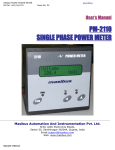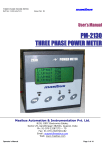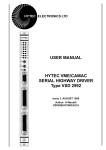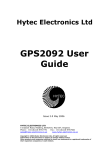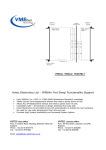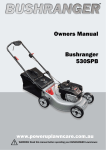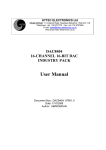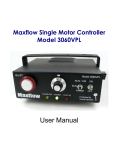Download SMDS4-B - Hytec Electronics Ltd
Transcript
UTM-SMDS4-B/A/X/3.0/ HYTEC ELECTRONICS Ltd HEAD OFFICE: 5 CRADOCK ROAD, READING, BERKS. RG2 0JT, UK Telephone: +44 (0) 118 9757770 Fax: +44 (0)118 9757566 E-mail: [email protected] SMDS4-BIPOLAR STEPPER MOTOR DRIVER USERS MANUAL Document Nos.: SMDS4-B/UTM/A/x/3.0 Date: 08/06/2007 Author: PJM -1- UTM-SMDS4-B/A/X/3.0/ CONTENTS 1. PRODUCT DESCRIPTION ...............................................................................................................................3 1.1 KEY FEATURES ..................................................................................................................................................4 2. SETTING UP .......................................................................................................................................................5 2.1 LOGIC CARD...................................................................................................................................................5 2.2 DRIVE CARD...................................................................................................................................................5 3. CONNECTING UP .............................................................................................................................................6 3.1 MOTORS/LIMIT SWITCHES .........................................................................................................................6 3.2 ENCODERS......................................................................................................................................................6 4. CURRENT LIMIT AND CONTROL................................................................................................................7 -2- UTM-SMDS4-B/A/X/3.0/ 1. PRODUCT DESCRIPTION The SMDS4-BIPOLAR is a 3U-high rack-mounted stepper motor driver for use with 4, 6 or 8lead hybrid stepper motors, driving in chopped (pulse-width-modulated) drive mode. The unit is controlled by an 8601 Hytec Electronics Ltd Industry Pack stepper motor controller via a rearmounted SCSI-2 interface connector. Through this, the SMDS4 receives STEP and DIRECTION signals from the 8601 and returns limit switch signals from each motor along with drive fault status and encoder signals. Additionally, the AUX1 output of the 8601 on each channel can be used to control the power ON/OFF function of each drive channel. This interface between the SMDS4 and the 8601 is opto-isolated in both directions. The unit contains a universal-AC-input power supply providing 300 watts of DC power at 24 volts to drive the motors which is also used to provide the 5 and 12-volt logic power supplies. The rear-panel IEC mains inlet is filtered, switched and fused. A fuse for the 12-volt logic supply is fitted on the rear panel. The SMDS4 system comprises six main printed circuit boards: The motherboard at the rear of the unit connects the logic card and drive cards together and to their power supplies. The logic card, on the left when looking from the front, provides an interface between the external controller and the drive cards, ensuring the correct signal levels are maintained, providing the correct width of step pulse and also turning motor power on and off if required. This card also houses the 5-volt regulator system. The four drive cards provide chopped bipolar drive to the motors at a current set by an 8-position DIL switch. This card also has an over-current detection system to prevent damage in the event of an external fault. Both logic card and drive cards have front panel indicators so that system status can be observed. Each drive card has a red ‘FAULT’ LED. The logic card has three LED’s for each channel: ‘RUN’ – GREEN LED lights when step pulses are received. ‘CW LIM’ and ‘CCW LIM’ – RED LED’s which come on if the corresponding limit switch is OPEN. The logic card also has one RED LED which illuminates if the 5-volt power supply fuse is open and a green LED to show that the 5-volt supply is present. At the rear of the system, mounted inside the rear hood, is the final card, the opto-isolated interface card to the external controller. This has a SCSI-2 connector for the cable to the VME chassis housing the 8601, four 15-way Cannon sockets, one for each channel, for additional signals such as encoder inputs, and an internal connector which connects to the motherboard. -3- UTM-SMDS4-B/A/X/3.0/ 1.1 Key Features • Four channels of Bipolar stepper motor drive at up to 4 amps per phase. • Direct SCSI cable connection to the 8601 Stepper IP card via transition card. • Limit switch and incremental encoder inputs on all four channels • Fully opto isolated on the VME/8601 side • Full over-current detection on all motor driving outputs – adjustable setting. • Circular connectors (Burndy G0B1492SNE) for each motor and its limit switches. • Fused, filtered and switched IEC mains inlet, 90-264 VAC, 50-60Hz. • Internal logic supplies of 12 volts and 5 volts regulated and fused with ‘fuse open’ indicators. -4- UTM-SMDS4-B/A/X/3.0/ 2. SETTING UP 2.1 LOGIC CARD There are four jumpers on the logic card; one for each channel. Each controls whether the motor for that channel is permanently enabled or turned off when there are no step pulses being received. Jumper J1 corresponds to motor 1, the drive card next to the logic card: J1 J1 J2 J2 J3 J3 J4 J4 IN OUT IN OUT IN OUT IN OUT Motor 1 turned off when no step pulses. Motor 1 always ON. Motor 2 turned off when no step pulses. Motor 2 always ON. Motor 3 turned off when no step pulses. Motor 3 always ON. Motor 4 turned off when no step pulses. Motor 4 always ON. 2.2 DRIVE CARDS Each drive card has three jumpers and a DIL switch system. The jumpers act as follows: J1: HALF/FULL Selects half or full step operation. IN = FULL STEP; OUT = HALF STEP. J2: L/R = chopped bipolar. Selects L/R drive mode, that is turns off the chopper action. IN = L/R; OUT Note: This jumper should ONLY be used when drive cards are constructed for L/R drive, that is with only half the output transistors fitted. J3: EXT/ENB. Controls the external enable signal from AUX1. IN = External enable connected; OUT = Controlled by Logic card. Note: AUX1 corresponds to the AUX1 writeable output bit in the 8601 CSR (bit 09). Users should not use both AUX1 control through J3 and logic card control. AUX1 = ‘0’, drivers ON; AUX1 = ‘1’, drivers OFF. The default selection of all these jumpers is OUT. The DIL switch has eight elements, each of which raises the motor current reference voltage by an amount equivalent to 0.6 amps. Note that as more switches are closed and the reference voltage rises, this effect will reduce to the point where the maximum current setting is four amps. -5- UTM-SMDS4-B/A/X/3.0/ 3. CONNECTING UP 3.1 MOTOR/LIMIT SWITCH CONNECTIONS. The motor connectors on this unit are Burndy G0B1492SNE circular connectors or direct equivalent. The pinout is as follows: Pin A B C D E F G H J -M Function PHASE A PHASE A’ PHASE B PHASE B’ N/C Clockwise limit Limits Common (GND) Counter-Clockwise limit N/C (no connect) The limit switch inputs on this card are compatible with voltage-free contacts from microswitches or the transistor outputs of opto switches. The wetting current of these inputs at 0.4 volts is 0.5mA and the wetting voltage is 12 volts. All these inputs are conditioned and opto-isolated before being sent to the 8601. The assumed function of these switch inputs is ‘Normally Closed’, meaning that an open condition indicates travel beyond the limit. If limit switches are not used in a system, the positive and negative travel limit switch inputs should be strapped to ground. The ‘Home’ limit switch input (see below) is only used in systems where the software function ‘go to home limit’ will be used. It therefore has no function and can be left open in systems where just the two travel limits are used. 3.2 Encoder Connections Each channel has a 15-way Cannon connector on the rear panel below the motor connector for encoder signals and some auxiliary signals. Pinout as follows: Pin 1 2 3 4 5 6 7 8 11 12 13 15 Function 5 volt VCC supply for encoder Encoder phase A+. Encoder phase A-. Encoder Index+. Encoder Index-. Encoder phase B+. Encoder phase B-. Encoder GND. Auxiliary Output 1 [opto-isolated from 8601 CSR bit 9]. Limits Common. Auxiliary Output 2 [opto-isolated from 8601 CSR bit 10]. Home limit input. -6- UTM-SMDS4-B/A/X/3.0/ The encoder inputs on this unit are compatible with any encoder which works with a 5-volt supply at up to 50 milliamps and gives TTL compatible quadrature outputs in phase A / phase B format. These signals are received and opto-isolated by the SMDS4 and fed to the 8601 where they are used to update the Absolute Position Accumulator if selected in the 8601 channel CSR. The AUX1 and AUX2 outputs are open collector drivers to ground, maximum ON current 2mA at VOUT = 1 volt, VOFF maximum is 12 volts. These outputs function as follows: CSR bit = ‘0’, output is OFF; CSR bit = ‘1’, output is ON. 4. CURRENT LIMIT AND CONTROL The drive card is fitted with over-current detection with a setting adjustable by potentiometer. This is set at manufacture to 6 amps. The action of the current limit is to trigger a monostable which turns off the output drive for a preset time, nominally 8 milliseconds. After this time, the outputs are re-enabled and, if the over-current condition persists, the system will shut off again. For the duration of the monostable timing, the FAULT output of the card will be driven high, resulting in the FAULT bit in 8601 CSR bit being set, cancelling the move. CURRENT REDUCTION BY REMOTE CONTROL. There is just one control signal brought to the drive card from the 8601 and this is AUX1, which as we saw above, this can be used to control the drive current ON/OFF function through J3. With a small modification, however, it is possible to use this signal to control the drive current by pulling down on the reference voltage. This modification can be implemented on customer request; contact Hytec for details. -7-








